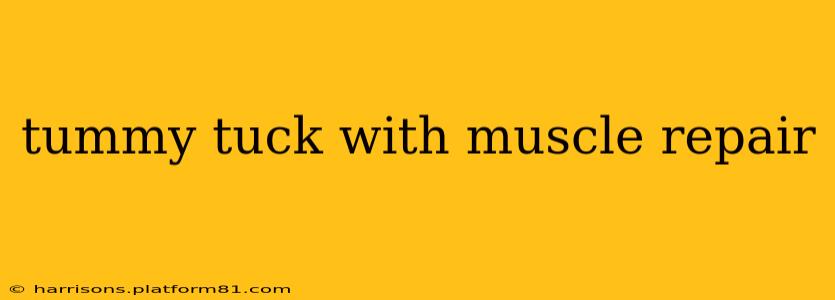A tummy tuck, also known as abdominoplasty, is a surgical procedure designed to remove excess fat and skin from the abdomen, resulting in a flatter, firmer stomach. But for many, the procedure goes beyond simply tightening skin. Many patients also opt for muscle repair, also known as plication, during their tummy tuck. This crucial element significantly enhances the results and overall body contouring. This comprehensive guide will explore the details of tummy tucks with muscle repair, addressing common questions and concerns.
What is Muscle Repair (Plication) During a Tummy Tuck?
During a tummy tuck with muscle repair, the surgeon tightens the abdominal muscles (rectus abdominis muscles) that have become separated – a condition known as diastasis recti. These muscles are typically separated by a band of connective tissue. The surgeon repairs this separation by suturing the muscles together, creating a tighter, more defined abdominal profile. This isn't just about aesthetics; it also offers functional improvements, providing better core support and potentially alleviating back pain associated with weakened abdominal muscles.
What are the Benefits of Combining a Tummy Tuck and Muscle Repair?
The benefits of combining a tummy tuck with muscle repair are numerous and extend beyond a simply flatter stomach:
- Improved Abdominal Contour: Muscle repair significantly improves the overall shape and definition of the abdomen, resulting in a more toned and sculpted appearance.
- Enhanced Core Strength: Tightening the abdominal muscles leads to improved core strength and stability, which can benefit posture and daily activities.
- Reduced Back Pain: For some individuals, diastasis recti can contribute to back pain. Muscle repair can help alleviate this pain by providing better support for the spine.
- More Permanent Results: While a tummy tuck alone can address excess skin and fat, muscle repair contributes to longer-lasting results by addressing the underlying muscle weakness.
- Increased Patient Satisfaction: The combination often leads to higher patient satisfaction with the overall outcome and body image improvement.
Who is a Good Candidate for a Tummy Tuck with Muscle Repair?
Ideal candidates for a tummy tuck with muscle repair are generally:
- Individuals with significant excess skin and fat in the abdomen.
- Those with weakened or separated abdominal muscles (diastasis recti).
- Patients who are at or near their ideal weight.
- Non-smokers who are in good overall health.
- Individuals with realistic expectations about the procedure and its outcomes.
How is a Tummy Tuck with Muscle Repair Performed?
The procedure is typically performed under general anesthesia. The surgeon makes an incision, usually low across the abdomen, to access the underlying muscles and tissues. The excess skin and fat are removed, and the abdominal muscles are repaired using sutures. The remaining skin is then redraped and sutured to create a smoother, tighter abdomen. The exact technique and incision placement can vary depending on the individual's anatomy and the surgeon's preferences.
What is the Recovery Time After a Tummy Tuck with Muscle Repair?
Recovery from a tummy tuck with muscle repair is more extensive than a tummy tuck alone. Expect several weeks of downtime, including:
- Initial Post-Operative Period (1-2 weeks): Pain, swelling, and bruising are common. Patients will need assistance with daily activities. Drains may be in place to remove excess fluid.
- Early Recovery (2-6 weeks): Swelling gradually reduces, but some discomfort may persist. Patients can begin light activity, but strenuous exercise should be avoided.
- Later Recovery (6-12 weeks): Most of the swelling and bruising have subsided. Patients can resume normal activities, but heavier lifting and intense exercise should be gradually reintroduced.
What are the Potential Risks and Complications of a Tummy Tuck with Muscle Repair?
As with any surgical procedure, there are potential risks and complications, including:
- Infection: The risk of infection at the incision site.
- Hematoma (blood clot): A collection of blood under the skin.
- Seroma (fluid collection): A collection of fluid under the skin.
- Poor Wound Healing: Delayed or impaired healing of the incision.
- Nerve Damage: Temporary or permanent numbness or tingling in the area.
- Unsatisfactory Cosmetic Results: The results may not meet the patient's expectations.
How Much Does a Tummy Tuck with Muscle Repair Cost?
The cost of a tummy tuck with muscle repair varies depending on several factors, including the surgeon's fees, anesthesia costs, facility fees, and geographic location. It's crucial to consult with multiple surgeons to obtain accurate cost estimates and compare their services.
Can I Combine a Tummy Tuck with Muscle Repair with Other Procedures?
Yes, a tummy tuck with muscle repair can often be combined with other procedures such as liposuction or breast surgery. This can streamline the process and achieve more comprehensive body contouring results. Your surgeon will discuss the feasibility and suitability of combining procedures based on your individual needs and anatomy.
This information is intended for general knowledge and informational purposes only, and does not constitute medical advice. It is essential to consult with a qualified plastic surgeon to determine your suitability for a tummy tuck with muscle repair and to discuss any specific questions or concerns you may have. Remember, a thorough consultation is key to making an informed decision about this procedure.
